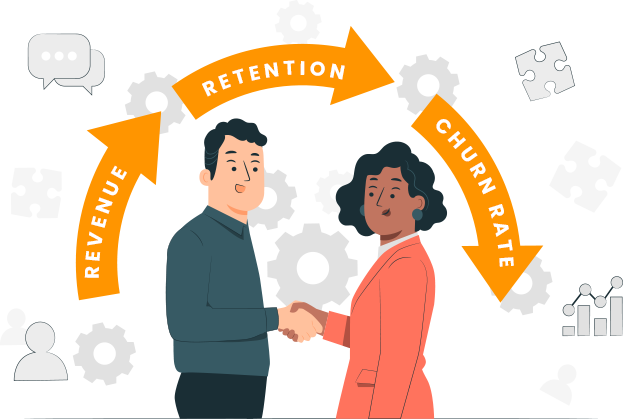

Customer Lifetime Value Examples: Understanding CLV
Customer Lifetime Value (CLV) gauges the revenue a customer will generate for your company over the entire duration of your business relationship.

Knowing this data is key to understanding where you should spend your marketing budget. That way, you won’t waste time and money marketing to customers who don’t purchase your products, or engage with your brand on other levels.
Customer Lifetime Value considers not only the initial purchase but any subsequent purchases, conversions, referrals, or other types of marketing the customer might generate. It also includes loyalty and satisfaction.
So by tracking CLV, you can make more informed business decisions and focus your energy on your highest-value clients with the highest ROI (return on investment).
Phew. I hope that makes sense!
Now I’m going to give you some Customer Lifetime Value examples (and teach you how to calculate them). That way you can improve your CLV and make more money.
Why is Customer Lifetime Value important for small businesses?
There’s a simple reason why CLV is super important for your small business:
Because it costs far more to attract a new customer than it does to retain one.
Even if you’re using a content-based strategy to bring in new leads through SEO, or social media campaigns, time is also money.
A well-crafted blog post, or Youtube video can take days or even weeks of your time. If you’re running ads on social media and acquiring clients from these avenues, marketing expenses can quickly add up.
The next thing you know you’re sleeping on your best friend’s couch.
Just kidding.
-
CLV lets you measure the financial impact of your marketing campaigns, and other activities so you can aim toward bigger financial targets
-
CLV can bring your focus to underutilized marketing channels so you can create more value and increase customer loyalty
-
CLV can help you adjust your short and long-term marketing goals based on your client data
-
It helps you spend less time marketing to unresponsive customers
-
CLV helps you provide a better customer experience to your most loyal customers
-
It helps you improve the quality of your products and services
-
Most of all, CLV helps you Improve relationships with existing customers and thus increases your business's overall profitability
To sum it up, understanding your Customer Lifetime Value is key to ensuring you’re providing your loyal customers with higher value. It will help increase profitability for all of your business, no matter how large or small it may be.
More resources here: Customer Lifetime Value case studies | more about Customer Lifetime Value
How to measure Customer Lifetime Value
While CLV can be estimated using various methods, the most important inputs are typically revenue, retention, and churn rate.
While there are various methods for estimating CLV, these three factors are typically the most important.
Revenue: The total amount of money that a customer spends throughout their relationship with a company.
Retention: The percentage of customers who remain loyal to a company over time.
Churn rate: The percentage of customers who cancel or do not renew their subscription with your company.
(you can see exactly how to calculate churn rate in this great guide)
Together, these three inputs can give a good approximation of CLV.
The formula looks like this:
CLV = Customer revenue - (subtracting) Cost of acquiring and retaining the customer.

Here’s a Customer Lifetime Value example:
Imagine your grandmother loves a certain type of specialty chocolate and you buy it for her birthday, from the same shop, every single year.
You’ve purchased that chocolate for the last ten years, at $27 a box.
CLV = $27 * 10 = $270
Your lifetime value is $270. This is assuming the shop didn’t spend any money on advertising to attract you.
If the shop had first attracted you with a direct mail flyer that cost them fifty cents, then you would subtract that from the CLV, making the CLV $265.50.
Understanding your customer’s lifetime value allows you to predict the CLV of other future customers.
Customer Lifetime Value calculation concepts
CAC:
Customer Acquisition Cost.
Customer acquisition cost, or CAC, is the cost of acquiring a single client.
This could include advertising costs, salaries for sales staff, or the cost of producing marketing materials.
If your CAC is high, it means you should rethink your marketing strategy. On the other hand, if your CAC is low, it could mean you're doing a great job of attracting customers.
Example: If the chocolate company invested $1000 a month in flyers, and attracted 400 new customers, the CAC is $1000/400 = $2.50
Gross Margin:
The amount of money a company retains after the costs of producing and selling its product.
If your gross margin is low, then you're not making enough profit per sale, and you'll need to either raise prices or find ways to reduce costs.
On the other hand, if your gross margin is too high, it could mean you're overcharging customers and may lose business to competitors.
Example: If it costs $1 to produce a chocolate, and the customer pays $1.10, then the gross margin is 10%
Average Lifetime:
The average amount of time a customer typically remains a customer.
Customer Lifetime Value calculation example:
Imagine Grandma loves chocolate so much that she starts her own chocolate shop. She decides to sell online through her eCommerce store.
After a few months, she wants to figure out her CLV.
It goes like this:
- New customers per month = 650 (N)
- A customer buys 2.5 boxes of chocolates on average (I)
- Average purchases per month = N*I = 1625 = (T)
- Her gross margin is about 15% (M)
- A customer spends on average $20 (S)
- Churn rate = 20%
- Average Lifetime (L) is 1/0.2 = 5 months (Note: 0.2 is the Churn rate)
CLV calculations 2
We’re not done yet.
- Overall profit from L months = T x S x M x L = $24375
- Profit per customer = 24375 / 650 = $37.50
- CLV = amount of money you make per customer - customer acquisition cost
- So CLV will be $37.50 - CAC
So if Grandma spends less than $37.50 per customer, she’s making money!
By the way, all of these calculations were borrowed from this Youtube channel. Credit to them.
How to increase Customer Lifetime Value
There's no surer way to business success than ensuring your customers keep coming back for more. But how do you do that? While there's no one-size-fits-all approach to increasing CLV, there are a few tried and true methods that can help.

1. Understand your customers
If you want to know your target market, take a long hard look at your existing customer base. Even if they’re a diverse group, they will have at least a few things in common.
Once you know the commonalities you can begin to target potential customers in a more refined way.
By studying your analytics, or running polls to your list, you can start to get a broader picture of who enjoys your product.
You can separate and alayze your existing base by:
- Age
- Sex
- Family size
- Household income
- Occupation
- Level of education
- Race
- Nationality
- Political leaning
- Religion
And once you have a solid understanding of your customer base’s demographics, you can then move on to segmenting them.

2. Segment your customers
To increase Customer Lifetime Value, you might segment by customers who are high spenders, or by those who are located in a certain area.
By understanding the different needs of your different customers, you can provide them with a more personalized experience that is tailored to them.
You can go deeper with segmentation, and create specific marketing campaigns targeted say, only at the Swedish women over 35 who enjoy yoga.
As a result, you're likely to see an increase in customer satisfaction and loyalty, which will ultimately raise your Customer Lifetime Value.

3. Create targeted marketing campaigns
If you have Netflix, you’ll notice they are great at marketing the types of movies and tv series to you. This is based on your previous viewing behavior.
Netflix’s average customer subscribes for 25 months. The CLV of a Netflix customer is $291.25.
When you use Netflix, they learn about you. They know what genres you enjoy, how long you usually watch for, and they use all of this data to market to you.
You should use your customer to market directly to your most loyal and valuable, or at least predictable, customers. Find out their likes, dislikes, and behaviors, then give them exactly the service they desire.

4. Use retention and upsell tactics
The art of selling isn't just about making a one-time transaction. It's about building relationships and finding ways to add value for your customers over the long term.
One way to do this is by using retention and upsell tactics.
For example, let's say you sell software that helps businesses manage their inventory. Once a business has signed up for your software, you can offer them additional features or upgrades that will help them save time and money.
Upselling can be a great way to increase revenues without having to find new customers. And it's not just about selling more stuff - it's also about providing more value for your existing customers.
This tactic can greatly increase your Customer Lifetime Value.

5. Analyze customer behavior
Customer behavior analysis is the study of customer behavior to improve customer service and loyalty.
It involves understanding why customers behave in certain ways, what their needs and wants are, and how they make decisions.
For example:
-
How long do they spend on your landing pages, and videos?
-
How often are they opening your marketing emails?
-
Which products do they prefer?
-
How likely are they to click on the links you send them?
By understanding customer behavior, businesses can develop marketing strategies that are more effective at attracting and retaining customers.
Additionally, you can identify potential problems that may cause customers to leave, and fix them. You wouldn’t want a broken link, or a poorly written piece of copy to cost you thousands of dollars, lowering your customers’ lifetime value.
Ultimately, analyzing customer behavior will help your business improve its bottom line by creating happier, more loyal customers.

6. Reward loyalty
There are a variety of ways to structure a loyalty program, but the basic idea is to give customers rewards for their continued business.
For example, you could offer a discount after a customer has made a certain number of purchases, or you could give away free products after a customer has referred a certain number of new customers.
Loyalty programs can be an effective way to increase Customer Lifetime Value, so it's worth considering if you're looking for ways to grow your small business.
The Wikipedia article on relationship marketing provides a solid overview of the important basic principles to understand in this field.
Conclusion
Improving your Customer Lifetime Value is important if you want to ensure the long-term success of your business.
There are many things you can do to improve Customer Lifetime Value, including:
- Segmenting and understanding your customers
- Creating loyalty programs
- Analyzing customer behavior
- Using retention and upsell tactics
- And rewarding loyalty
All of these strategies will help you keep your existing customers happy and coming back for more, while also attracting new customers.
Have you implemented any of these strategies in your business? If so, what has been the result?
Leave a comment below and let us know.


